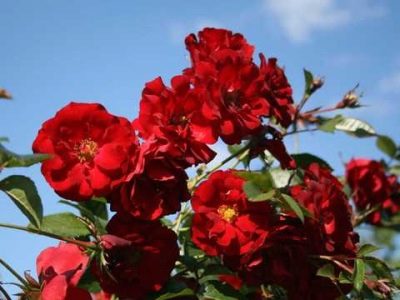
- Authors: Hans Jürgen Evers
- Name synonyms: Austriana, Tananaistrua
- Breeding year: 1996
- Group: floribunda
- The main color of the flower: red
- Flower shape: flat-bowl
- Flower size: medium
- Diameter, cm: 5-7
- Flower type by number of petals: semi-double
- Scent: no scent
The variety of Austrian roses appeared in our gardeners relatively recently. It is a beautiful plant with many benefits and no unique scent. It is widely used in landscape design.
Breeding history of the variety
Breeders in Germany were engaged in breeding the Austrian variety. Domestic plant breeders got the opportunity to enjoy the flower only in 1996. The variety belongs to the floribunda type.
Description of the variety
Austriana's buds have a dark red hue, which attracts many gardeners. When they bloom, the flowers acquire a lighter shade - scarlet, while the yellow stamens are clearly visible.
Austriana is very richly colored, it looks great in the garden and stands out there among other flowers. One of its main advantages is that the flower does not fade in the sun.
The buds are formed oval, the flowers are flat-shaped, medium-sized, medium-sized. In diameter, each flower can reach from 5 to 7 cm. This is a semi-double type of roses. Petals are usually from 8 to 15 pieces.
Up to 12 flowers can grow on one stem; Austriana has multi-flowered inflorescences.
It is worth saying that this rose does not have any aroma, rather it attracts with its appearance and brightness.
Austriana bushes grow quite compact, usually no more than 70 cm with a diameter of 60 cm. The foliage is medium in size, with an attractive dark green hue.
The Austrian rose variety has a moderate drought tolerance, it is well accepted in regions where high air temperatures prevail in summer. This flower does not suffer from root rot during prolonged rains and does not fade in the sun.
Advantages and disadvantages
To understand whether it is worth planting Austrian in your garden, you need to evaluate its benefits:
bright color;
unpretentiousness to climatic conditions;
compactness;
resistance to some common diseases.
This flower has only one drawback - it has no smell.
Flowering features
Austriana has a long flowering period, the buds bloom in June and delight with their brightness until frost, in some regions it is October. Austriana blooms very profusely, some flowers are replaced by others, but in general the picture does not deteriorate. This variety of roses is referred to as re-flowering.
Use in landscape design
Austrian is often grown for bouquets, because it looks especially impressive in them. In addition, this variety looks great in group plantings in rose gardens or just in a flower bed.
Landing
The planting density of Austriana is 4-5 bushes per square meter. The pit should be such that the entire root system of the bush fits into it normally. Drainage from pebbles or expanded clay is laid at the bottom, a nutritious soil mixture is placed on top.
By immersing Austrian in the planting hole, the roots are straightened, covered with earth from above, lightly tamped to eliminate the appearance of air pockets. At the end of planting, the bush is watered with warm water.
Growing and caring
For roses of this variety, you should choose a sunny place with fertile and loose soil. It is imperative that it is well drained and enriched with minerals.
The recommended acidity pH for this variety is 6.5. If the soil in the garden is too acidic, lime or chalk should be used before planting Austriana. About 0.5 kg of chalk per 1 m2 is enough to raise the soil pH value from 0.5 to 1.0.
Watering and feeding
It is necessary to water Austrian roses twice a week if there was no rainfall. On the bush leaves from 10 liters of water, but no more than 15 is required. If precipitation falls regularly on the street, then watering is not worth it.
To improve the soil structure for Austriana, it is advisable to add various organic fertilizers such as peat, pine bark, brown coal or manure. Peat mixed with light soil will retain water and minerals in it. If it is too dense, silty, we can weaken it with pine bark. The bark will decompose in the soil for a long time and enrich the soil within four years. The recommended dose is 20 to 40 liters per m2. Adding bark to the soil requires the simultaneous addition of nitrogen.
Brown coal prevents nutrients in the soil from leaching out. Manure enriches the soil with humus and mineral elements. When applying manure, it should be remembered that the land for planting Austriana must be prepared several weeks before planting the bushes, since the roots of the roses should not come into contact with fresh fertilizer.
Pruning
Pruning of this variety of roses is done in the fall. It is only required to slightly shorten the shoots, since the bushes do not grow tall anyway.
Frost resistance and preparation for winter
Rose Austrian has a high degree of frost resistance. It can grow quietly in the 5-6 zone. Withstands a maximum drop in air temperature to –29 degrees Celsius.
Young bushes can be provided with a small light shelter in the form of old foliage, adult perennials survive perfectly in winter.
Diseases and pests
Austriana has a genetically built high immunity to various diseases characteristic of roses. This variety is not affected by powdery mildew and has a medium resistance to black spot.































































